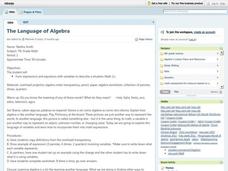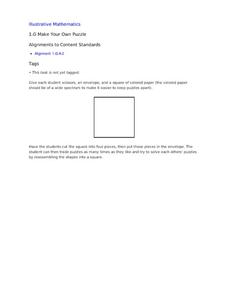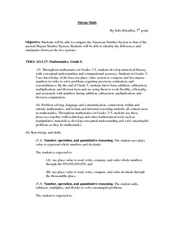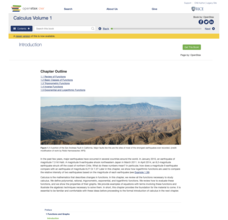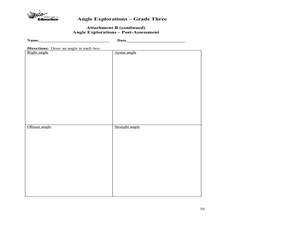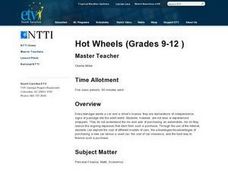Curated OER
House and Holmes: A Guide to Deductive and Inductive Reasoning
Test your pupils' reasoning skills with several activities and a quick mystery to solve. Learners watch and analyze a few video clips that demonstrate reasoning in action, practice deduction with an interactive and collaborative...
Mathematics Vision Project
Module 5: Features of Functions
The language and features of functions get careful treatment in a complex but doable lesson. Learners get a lot of practice really figuring out what a graph means in context, and also identifying key features of graphs. Key ideas...
Curated OER
The Language of Algebra
Young scholars compare the language of algebra to a foreign language. They play the game "Pictionary" to emphasize that pictures can represent words. After writing definitions and discussing the meaning of variable expressions,...
West Contra Costa Unified School District
Expository Writing in Math
Pupils engage in an activity where one partner reads directions while the other follows those directions to complete a math task (such as bisecting an angle). As a reflection, they examine products to see what information the best...
Illustrative Mathematics
Grass Seedlings
Plants never grow at the same rate, and that is the antithesis for this word problem involving multiplication of fractions. On the activity, Raul notices that Pablo's seedlings are 1 1/2 times as tall, and Celina's seedlings are 3/4 as...
Illustrative Mathematics
Make Your Own Puzzle
Puzzling over what geometry lesson to teach next? Look no further. This simple activity teaches young mathematicians how shapes can be decomposed into smaller figures, and how smaller figures can be assembled into larger shapes. To learn...
Curated OER
Function Lesson Plan -- Asking for Repetition
Young scholars with disabilities are tested in the use of language and taught the skill of asking for repetition in order to gain clarification and thus improve comprehension. They are assessed according to the practice of asking with...
Curated OER
The Dot and Dashy Language
Students examine and discuss the Morse Code. In small groups they develop messages using Morse code and take turns decipering the messages.
Curated OER
Business Letters: Writing a Letter of Complaint
Students analyze the language features and layout of a letter and discuss the language used to describe the features. They write a letter of complaint, requesting that the problem be fixed, using the appropriate language and layout.
Curated OER
Fly, Fly Away
High schoolers use materials from their own environment to design a kite. In this kite design lesson, students research the history of kites and obtain a formal mathematical definition of a kite. High schoolers sketch kite designs after...
Curated OER
New York City Delights: The Taxi Cab
You set the rate! Step into the shoes of a taxi driver in New York City, and also pretend to be a person who uses taxis to get around town. The class will conduct collaborative research to learn about the history of taxis. Then, they...
Curated OER
Pythagorean Theorem Proof
Tenth graders investigate the Pythagorean Theorem. Then they type up a formal paragraph proof of a proof of their choice.
Curated OER
Polygons
Fourth graders identify and describe lines, shapes, and solids using formal geometric language. They use Inspiration to create a graphic organizer and outline of polygons.
Curated OER
Name Clothesline Graph
Student matches the initial letter of his/her name with the corresponding letter on the clothesline. They then participate in the classroom discussions by offering information relevant to the topic and answering or asking questions...
Curated OER
Design Explorations: Frieze Patterns
Students will explore frieze patterns. A frieze pattern is a mathematical concept to classify designs on two-dimensional surfaces, which are repetitive in one direction, based on the symmetries in the pattern. They will explore examples...
Curated OER
Mayan Math
Fifth graders investigate the Maya's as mathematicians. In this Mayan math lessons, 5th graders work with the ancient Mayan numbering system by comparing it to the American Number System. They tell the differences and similarities...
Curated OER
Fraction Puzzle Problems
Fifth graders design a fraction word problem PowerPoint presentation. In small groups they complete a storyboard graphic organizer for their word problem, evaluate another group's word problem, and create a PowerPoint presentation of...
Rice University
Calculus Volume 1
Differentiate between calculus concepts. The beginning of a helpful calculus resource begins with a short review of functions and moves right into limits to define derivatives. The six-chapter resource continues with applications of...
Curated OER
Fabulous Fractals
Young scholars view a video to discover how patterns in nature relate to math. They explore the concept of exponential growth by observing and creating fractals. They solve and design word problems.
Curated OER
Angle Explorations
Third graders observe angles in their classroom and create an angle finder to represent them.In this angles lesson, 3rd graders classify angles as acute, obtuse, right or straight. Students find the differences and similarities in angles.
Curated OER
Hot Wheels (Grades 9-12 )
Using internet research, students compute the costs of different models of card. They discuss the advantages/disadvantages of purchasing a new car versus a used car, the cost of car insurance, and the best way to finance their purchase.
Curated OER
CSI Rhino
Students study the rhinoceros and how the species has survived for so long. In this rhino lesson students create graphs and research what is being done to protect the rhino.
Curated OER
Global Warming Statistics
Students research real-time and historic temperature data of U.S. and world locations, and analyze the data using mean, median, and mode averages. They graph the data and draw conclusions by analyzing the data. A spreadsheet is used to...
Curated OER
Polar Bear Panic!
Students identify the three realms of the Arctic Ocean, and describe the relationships between these realms. They graphically analyze data on sea ice cover in the Arctic Ocean, and recognize a trend in these data.


